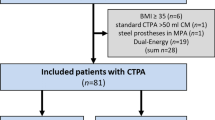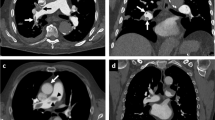Abstract
The aim of this study was to assess the feasibility of minimising contrast-medium (CM) doses using 80-peak kilovoltage (kVp) 16-channel multidetector computed tomography (MDCT) with CM dose tailored to body weight, when diagnosing pulmonary embolism (PE) in azotaemic patients. Twenty-nine patients (68–93 years; 38–79 kg) with an estimated glomerular filtration rate of 12–49 ml/min underwent 80 kVp MDCT at a median dose of 200 mg iodine (I)/kg and 15 s injection time. Pulmonary artery (PA) enhancement where compared with our own reference material using 320 mg I/kg at 120 kVp and with reported figures in the literature at 120–140 kVp and a 42 g iodine CM dose. Median (1st and 3rd quartiles) values regarding CM dose were 12.2 (9.9–12.8) g iodine; density of left main and lower lobe segmental PA 339 (275–395) Hounsfield units (HU) and 354 (321–442) HU, respectively. Those enhancement values were similar to those obtained from the reference population at 120 kVp and those reported in the literature at 120–140 kVp. One patient had a transient increase in plasma creatinine. Three months’ follow-up revealed deep venous thrombosis among 1/18 patients with negative results from computed tomography (CT). We conclude that 80 kVp 16-channel MDCT to diagnose PE in azotaemic patients may be performed with markedly reduced CM doses, implying a lesser risk for CM-induced nephropathy.



Similar content being viewed by others
References
Remy-Jardin M, Remy J, Wattinne L, Giraud F (1992) Central pulmonary thromboembolism: diagnosis with spiral volumetric CT with the single-breath-hold technique—comparison with pulmonary angiography. Radiology 185:381–387
Gleeson TG, Bulugahapitiya S (2004) Contrast-induced nephropathy. AJR Am J Roentgenol 183:1673–1689
The Swedish Council on Technology Assessment in Health Care (2002) SBU Report 158/II. Prophylaxis, diagnosis and treatment of venous thromboembolism. The Swedish Council on Technology Assessment in Health Care, Stockholm, Sweden
Bourriot K, Couffinhal T, Bernard V, Montaudon M, Bonnet J, Laurent F (2003) Clinical outcome after a negative spiral CT pulmonary angiographic finding in an inpatient population from cardiology and pneumology wards. Chest 123:359–365
Coche E, Verschuren F, Keyeux A, Goffette P, Goncette L, Hainaut P, Hammer F, Lavenne E, Zech F, Meert P, Reynaert MS (2003) Diagnosis of acute pulmonary embolism in outpatients: comparison of thin-collimation multi-detector row spiral CT and planar ventilation–perfusion scintigraphy. Radiology 229:757–765
Reinartz P, Wildberger JE, Schaefer W, Nowak B, Mahnken AH, Buell U (2004) Tomographic imaging in the diagnosis of pulmonary embolism: a comparison between V/Q lung scintigraphy in SPECT technique and multislice spiral CT. J Nucl Med 45:1501–1508
Winer-Muram HT, Rydberg J, Johnson MS, Tarver RD, Williams MD, Shah H, Namyslowski J, Conces D, Jennings SG, Ying J, Trerotola SO, Kopecky KK (2004) Suspected acute pulmonary embolism: evaluation with multi-detector row CT versus digital subtraction pulmonary arteriography. Radiology 233:806–815
Kavanagh EC, O’Hare A, Hargaden G, Murray JG (2004) Risk of pulmonary embolism after negative MDCT pulmonary angiography findings. AJR Am J Roentgenol 182:499–504
Perrier A, Roy PM, Sanchez O, Le Gal G, Meyer G, Gourdier AL, Furber A, Revel MP, Howarth N, Davido A, Bounameaux H (2005) Multidetector-row computed tomography in suspected pulmonary embolism. N Engl J Med 352:1760–1768
Schoellnast H, Deutschmann HA, Fritz GA, Stessel U, Schaffler GJ, Tillich M (2005) MDCT angiography of the pulmonary arteries: influence of iodine flow concentration on vessel attenuation and visualization. AJR Am J Roentgenol 184:1935–1939
Bedard JP, Blais C, Patenaude YG, Monga E (2005) Pulmonary embolism: prospective comparison of iso-osmolar and low-osmolarity nonionic contrast agents for contrast enhancement at CT angiography. Radiology 234:929–933
Goodman LR, Gulsun M, Nagy P, Washington L (2005) CT of deep venous thrombosis and pulmonary embolus: does iso-osmolar contrast agent improve vascular opacification? Radiology 234:923–928
Bae KT, Mody GN, Balfe DM, Bhalla S, Gierada DS, Gutierrez FR, Menias CO, Woodard PK, Goo JM, Hildebolt CF (2005) CT depiction of pulmonary emboli: display window settings. Radiology 236:677–684
Dorio PJ, Lee FT Jr, Henseler KP, Pilot M, Pozniak MA, Winter TC 3rd, Shock SA (2003) Using a saline chaser to decrease contrast media in abdominal CT. AJR Am J Roentgenol 180:929–934
Fleischmann D (2003) Use of high-concentration contrast media in multiple-detector-row CT: principles and rationale. Eur Radiol 13 [Suppl 5]:M14–M20
Awai K, Hiraishi K, Hori S (2004) Effect of contrast material injection duration and rate on aortic peak time and peak enhancement at dynamic CT involving injection protocol with dose tailored to patient weight. Radiology 230:142–150
Huda W, Scaletti EM, Levin G (2000) Technique factors and image quality as function of patient weight at abdominal CT. Radiology 217:430–435
Boone JM, Geraghty EM, Seibert JA, Wootton-Gorges SL (2003) Dose reduction in pediatric CT: a rational approach. Radiology 228:352–360
National Kidney Foundation (2002) National Kidney Foundation Guidelines for chronic kidney disease: evaluation, classification, and stratification. Am J Kidney Disease 2 [Suppl 1]:S46–S110
Cockcroft DW, Gault MH (1976) Prediction of creatinine clearance from serum creatinine. Nephron 16:31–41
Nyman U, Ahl TL, Kristiansson M, Nilsson L, Wettemark S (2005) Patient-circumference-adapted dose regulation in body computed tomography. A practical and flexible formula. Acta Radiol 46:396–406
Nagel HD, Galanski M, Hidajat N, Maier W, Schmidt T (2002) Radiation exposure in computed tomography. Fundamentals, influencing parameters, dose assessment, optimization, scanner data, terminology. CTB Publications, Hamburg
New PFJ, Aronow S (1976) Attenuation measurements of whole blood and blood fractions in computed tomography. Radiology 121:635–640
Norman D, Price D, Boyd D, Fishman R, Newton TH (1977) Quantitative aspects of computed tomography of the blood and cerebrospinal fluid. Radiology 123:335–338
Boone JM, Nelson TR, Lindfors KK, Seibert JA (2001) Dedicated breast CT: radiation dose and image quality evaluation. Radiology 221:657–667
Wilting JE, Zwartkruis A, van Leeuwen MS, Timmer J, Kamphuis AGA, Feldberg M (2001) A rational approach to dose reduction in CT: individual scan protocols. Eur Radiol 11:2627–2632
Cham MD, Yankelevitz DF, Shaham D, Shah AA, Sherman L, Lewis A, Rademaker J, Pearson G, Choi J, Wolff W, Prabhu PM, Galanski M, Clark RA, Sostman HD, Henschke CI (2000) Deep venous thrombosis: detection by using indirect CT venography. The Pulmonary Angiography–Indirect CT Venography Cooperative Group. Radiology 216:744–751
Sigal-Cinqualbre AB, Hennequin R, Abada HT, Chen X, Paul JF (2004) Low-kilovoltage multi-detector row chest CT in adults: feasibility and effect on image quality and iodine dose. Radiology 231:169–174
Bae KT, Heiken JP, Brink JA (1998) Aortic and hepatic contrast medium enhancement at CT. Part II. Effect of reduced cardiac output in a porcine model. Radiology 207:657–662
Society of Pediatric Radiology (2002) The ALARA (as low as reasonablly achievable) concept in pediatric CT intelligent dose reduction: multidisciplinary conference organized by the Society of Pediatric Radiology, August 18-19, 2001. Pediatr Radiol 32:217–313
Cigarroa RG, Lange RA, Williams RH, Hillis LD (1989) Dosing of contrast material to prevent contrast nephropathy in patients with renal disease. Am J Med 86:649–652
McCullough PA, Wolyn R, Rocker LL, Levin RN, O’Neill WW (1997) Acute renal failure after coronary intervention: Incidence, risk factors, and relationship to mortality. Am J Med 103:368–375
Nyman U, Almén T, Aspelin P, Hellström M, Kristiansson M, Sterner G (2005) Contrast- medium-induced nephropathy correlated to the ratio between dose in gram iodine and estimated GFR in ml/min. Acta Radiol 46:830–842
Loud PA, Katz DS, Klippenstein DL, Shah RD, Grossman ZD (2000) Combined CT venography and pulmonary angiography in suspected thromboembolic disease: diagnostic accuracy for deep venous evaluation. AJR Am J Roentgenol 174:61–65
Baldt MM, Zontsich T, Stumpflen A, Fleischmann D, Schneider B, Minar E, Mostbeck GH (1996) Deep venous thrombosis of the lower extremity: efficacy of spiral CT venography compared with conventional venography in diagnosis. Radiology 200:423–428
Kanne JP, Gotway MB, Thoongsuwan N, Stern EJ (2003) Six cases of acute central pulmonary embolism revealed on unenhanced multidetector CT of the chest. AJR Am J Roentgenol 180:1661–1664
Strunk HM, Schild H (2004) Actual clinical use of gadolinium chelates for non-MRI applications. Eur Radiol 14:1055–1062
Coche EE, Hammer FD, Goffette PP (2001) Demonstration of pulmonary embolism with gadolinium-enhanced spiral CT. Eur Radiol. 11:2306–2309
Remy-Jardin M, Dequiedt P, Ertzbischoff O, Tillie-Leblond I, Bruzzi J, Duhamel A, Remy J (2005) Safety and effectiveness of gadolinium-enhanced multi-detector row spiral CT angiography of the chest: preliminary results in 37 patients with contraindications to iodinated contrast agents. Radiology 235:819–826
Rémy-Jardin m, Bahépar J, Lafitte JJ, Dequiedt P, Ertzbischoff O, Bruzzi J, Duhamel A, Rémy J (2005) 16-slice multidetector CT angiography of the pulmonary circulation using gadolinium-based contrast agents: prospective evaluation in 60 patients. Eur Radiol 15 [Suppl 1]:268
Nyman U, Elmståhl B, Leander P, Nilsson M, Golman K, Almen T (2002) Are gadolinium-based contrast media really safer than iodinated media for digital subtraction angiography in patients with azotemia? Radiology 223:311–318
HS Thomsen, T Almén, SK Morcos and members of the Contrast Media Safety Committee of the European Society of Urogenital Radiology (ESUR) (2002) Gadolinium-containing contrast media for radiographic examinations: a position paper: Eur Radiol 12:2600–2605
Elmståhl B, Nyman U, Leander P, Chai CM, Frennby B, Almen T (2004) Gadolinium contrast media are more nephrotoxic than a low osmolar iodine medium employing doses with equal X-ray attenuation in renal arteriography: an experimental study in pigs. Acad Radiol 11:1219–1228
Elmståhl B, Nyman U, Leander P, Golman K, Almén T, Chai CM, Pehrsson R (2005) Nephrotoxicity after renal arteriography with “low”- and “iso-osmolar” iodine and gadolinium contrast media (CM) in an experimental model. Eur Radiol 15 [Suppl 1]:332
Sam AD, Morasch MD, Collins J, Song G, Chen R, Pereles FS (2003) Safety of gadolinium contrast angiography in patients with chronic renal insufficiency. J Vasc Surg 38:313–318
Heyman SN, Reichman J, Brezis M (1999) Pathophysiology of radiocontrast nephropathy: a role for medullary hypoxia. Invest Radiol 34:685–691
Acknowledgement
We wish to thank librarian Elisabeth Sassersson for excellent service regarding literature references.
Author information
Authors and Affiliations
Corresponding author
Rights and permissions
About this article
Cite this article
Holmquist, F., Nyman, U. Eighty-peak kilovoltage 16-channel multidetector computed tomography and reduced contrast-medium doses tailored to body weight to diagnose pulmonary embolism in azotaemic patients. Eur Radiol 16, 1165–1176 (2006). https://doi.org/10.1007/s00330-005-0117-x
Received:
Revised:
Accepted:
Published:
Issue Date:
DOI: https://doi.org/10.1007/s00330-005-0117-x




